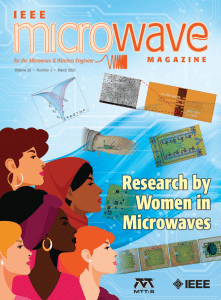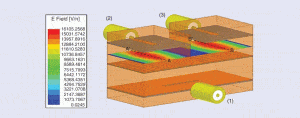Microwave Magazine WiM Focus Issues
Since its inaugural issue in 2022, the IEEE Microwave Theory and Technology Society (MTT-S) has each year published a focus issue on research by women in microwaves in IEEE Microwave Magazine. These focus issues highlight scientific articles by female researchers and spotlight their research. Through these focus issues, we hope to bring attention to these female researchers and their publications.
March 2025 Focus Issue on Research by WiM
Guest Editor: Kiki Ikossi
This is the fourth year in a row that we have a Microwave Magazine focus issue devoted to WiM, organized by Kiki Ikossi.
It is with great pleasure that five invited research articles from women microwave engineers, which have undergone a rigorous peer review, are highlighted in this 2025 focus issue of the IEEE Microwave magazine. Women engineers are performing research in all areas of the Microwave Theory and Technology Society’s spectrum, from microwave materials and interconnects to sensors and systems.
We would like to thank the organizer of this year’s focus issue, Kiki Ikossi, for communicating with the authors from initial discussions through to final acceptance of their peer-reviewed articles. Kiki has provided an excellent “From the Guest Editor’s Desk” column outlining the issue.
Take a look at her insights before diving into the WiM research articles:
https://ieeexplore.ieee.org/stamp/stamp.jsp?tp=&arnumber=10876880
– WiM Media Working Group 2025
Exploring the Potential of Semiconductors at Millimeter-Wave Frequency: From Permittivities to Applications
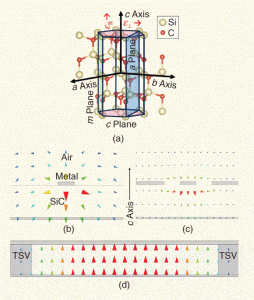 Precise modeling and characterization of material permittivity are essential for high-frequency devices operating above 110 GHz. However, existing data at millimeter-wave frequencies are limited, and measurements from different laboratories and techniques on the same material often vary by much as 10%.
Precise modeling and characterization of material permittivity are essential for high-frequency devices operating above 110 GHz. However, existing data at millimeter-wave frequencies are limited, and measurements from different laboratories and techniques on the same material often vary by much as 10%.
This article reviews challenges and methodologies for permittivity measurements, using high-purity semi-insulating 4H SiC—a material essential for high-frequency and harsh-environment applications—as an example. We highlight advancements utilizing Fabry-Perot resonators and substrate-integrated waveguides to measure ordinary and extraordinary permittivities, ε⊥ and ε‖, and their respective loss tangents across 55–330 GHz. Without measurement artifacts, the measured values of ε⊥ = 9.77 ± 0.01 and ε‖ = 10.20 ± 0.05 show negligible frequency dependence, while the measured tan δ⊥ of (4.9 ± 0.1) × 10−6 f increases linearly with the frequency f. The value tan δ⊥ = 3 × 10−5 is the lowest we have measured on any solid and is lower than the previous low-loss standards like sapphire. Applications in millimeter-wave circuits, including state-of-the-art D-band power amplifiers, validate these findings, underscoring their importance for next-generation communication systems such as 6G.
Read the full article by Li et al. on Microwave Magazine here:
https://ieeexplore.ieee.org/stamp/stamp.jsp?tp=&arnumber=10876853
– WiM Media Working Group 2025
Uniting Integration: Advancing RF Interconnect Technologies
The WIM Special Session in APMC 2024: Prestigious Moments With Distinguished Women in Microwave
Recently, advancing RF interconnect technologies for future 2.5D and 3D integration have been identified as an important game changer for energy efficient complex integrated circuit systems. Researchers are improving the performance of traditional interconnect technologies, such as wire bonds, and are exploring novel technologies as alternative interconnect solutions, such as stich chip and copper nanowire vias. Due to the high speed needs of 5G and 6G communication, interconnect operation needs to extend into the millimeter and sub-millimeter wave frequency range, which poses big challenges for designs with low loss and broad bandwidth. Herein, this review discusses and describes recent advances in interconnect technologies for wired and wireless RF applications. The research work is promising and shows a variety of methods to achieve low loss over a broad range of frequencies needed to truly enable design of energy efficient complex integrated circuit systems.
Read the full article in Microwave Magazine here:
https://ieeexplore.ieee.org/stamp/stamp.jsp?tp=&arnumber=10876855
– WiM Media Working Group 2025
A Miniaturized Flexible Surface Electromyography Sensor With an Integrated Localization Concept
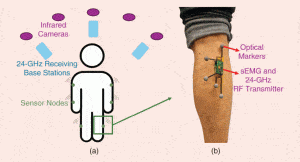 This work aims to give an overview of a novel localization concept for sEMG sensing that was developed by the authors. In the context of our research within the EmpkinS project, we have developed a miniaturized, flexible, and localizable sEMG sensor. To enable absolute localization of the sensor, a localization concept based on a holographic extended Kalman filter (HEKF) was developed. To this end, a low-power 24-GHz RF transmitter was integrated into the sensor, which sends out continuous-wave (CW) signals in the industrial, scientific, and medical (ISM) band. Additionally, sEMG sensor data are transmitted over the RF signal by means of amplitude shift keying (ASK). Three 24-GHz receiving base stations are distributed in the measurement environment. The localization function is capable of functioning even when the test person is attired in clothing, which results in a more comfortable environment for the test person during the motion recording. To allow for comparison of our proposed method with the state-of-the-art optical-based method by using infrared cameras, five optical markers were affixed to the sensor.
This work aims to give an overview of a novel localization concept for sEMG sensing that was developed by the authors. In the context of our research within the EmpkinS project, we have developed a miniaturized, flexible, and localizable sEMG sensor. To enable absolute localization of the sensor, a localization concept based on a holographic extended Kalman filter (HEKF) was developed. To this end, a low-power 24-GHz RF transmitter was integrated into the sensor, which sends out continuous-wave (CW) signals in the industrial, scientific, and medical (ISM) band. Additionally, sEMG sensor data are transmitted over the RF signal by means of amplitude shift keying (ASK). Three 24-GHz receiving base stations are distributed in the measurement environment. The localization function is capable of functioning even when the test person is attired in clothing, which results in a more comfortable environment for the test person during the motion recording. To allow for comparison of our proposed method with the state-of-the-art optical-based method by using infrared cameras, five optical markers were affixed to the sensor.
Read the full article in Microwave Magazine here:
https://ieeexplore.ieee.org/stamp/stamp.jsp?tp=&arnumber=10876860
– WiM Media Working Group 2025
The Integration of Machine Learning in Microwave Dielectric Sensing: From Design to Postprocessing
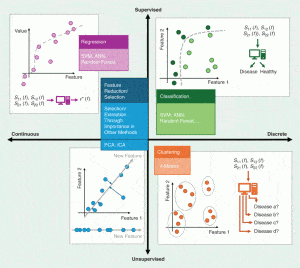 Microwave sensors are popular for characterizing materials non-invasively. Traditionally, designing these sensors and processing the data obtained from them requires a lot of trial and error and complex processing algorithms. Machine learning (ML) can offer a faster and more efficient way to improve the material characterization process through optimized sensor shapes, improved sensitivity, and more efficient and accurate material properties extraction. This article reviews how ML techniques are used in microwave dielectric sensing to improve sensor design, data processing, and measurement reliability. It also explores current challenges and opportunities, highlighting how ML can help sensors adapt to changing conditions and optimize performance in various situations. Overall, the research shows the important role ML can play in making microwave dielectric sensing more efficient, accurate, and scalable.
Microwave sensors are popular for characterizing materials non-invasively. Traditionally, designing these sensors and processing the data obtained from them requires a lot of trial and error and complex processing algorithms. Machine learning (ML) can offer a faster and more efficient way to improve the material characterization process through optimized sensor shapes, improved sensitivity, and more efficient and accurate material properties extraction. This article reviews how ML techniques are used in microwave dielectric sensing to improve sensor design, data processing, and measurement reliability. It also explores current challenges and opportunities, highlighting how ML can help sensors adapt to changing conditions and optimize performance in various situations. Overall, the research shows the important role ML can play in making microwave dielectric sensing more efficient, accurate, and scalable.
Read the full article in Microwave Magazine here:
https://ieeexplore.ieee.org/stamp/stamp.jsp?tp=&arnumber=10876879
– WiM Media Working Group 2025
March 2024 Focus Issue on Research by WiM
Guest Editor: Jasmin Grosinger
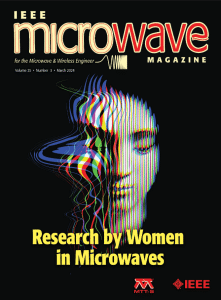 This is the third year in a row for a WiM-focused issue, with five technical features for you to read in this issue and two more that will appear in the May 2024 issue. We thank the organizer of the WiM focus issue, Jasmin Grosinger, for working with the authors and the Microwave Magazine editorial office to move the issue forward:
This is the third year in a row for a WiM-focused issue, with five technical features for you to read in this issue and two more that will appear in the May 2024 issue. We thank the organizer of the WiM focus issue, Jasmin Grosinger, for working with the authors and the Microwave Magazine editorial office to move the issue forward:
This year, we are proud to present articles by seven female colleagues. In two issues, we will feature seven articles. Kumari et al. present research on microwave imaging, sensing, and nondestructive testing, while Zeng and Yu review noncanonical microwave filter synthesis. Fatima et al. focus on radio frequency energy harvesting systems using frequency-selective surfaces. Xiang et al. deal with de-embedding technologies for device testing in the microwave and terahertz bands, while Faghih-Naini et al. discuss aspects of hardware design and modulation schemes in joint communication and sensing..
Read the “From the Guest Editor’s Desk” column on this focus issue in Microwave Magazine here:
https://ieeexplore.ieee.org/stamp/stamp.jsp?tp=&arnumber=10421755
– WiM Media Working Group 2025
Frequency Selective Surface Structures-Based RF Energy Harvesting Systems and Applications
 With the recent developments in the field of ultralow-power wearable and portable electronic gadgets and wireless sensor networks, the number of devices and sensors in a system has increased significantly [1]. The emergence of the Internet of Things has added many additional devices and sensors connected via the Internet [2], [3]. It is also anticipated that the number of connected devices will continue to increase in the coming years [4]. Currently, batteries remain the only source of power for these interconnected devices and systems. This article presents research on microwave imaging, sensing, and nondestructive testing.
With the recent developments in the field of ultralow-power wearable and portable electronic gadgets and wireless sensor networks, the number of devices and sensors in a system has increased significantly [1]. The emergence of the Internet of Things has added many additional devices and sensors connected via the Internet [2], [3]. It is also anticipated that the number of connected devices will continue to increase in the coming years [4]. Currently, batteries remain the only source of power for these interconnected devices and systems. This article presents research on microwave imaging, sensing, and nondestructive testing.
Read the full article in Microwave Magazine here:
https://ieeexplore.ieee.org/stamp/stamp.jsp?tp=&arnumber=10421772
– WiM Media Working Group 2025
De-Embedding Technology for Active and Passive Device Testing Used in the Microwave and Terahertz Bands: A Review
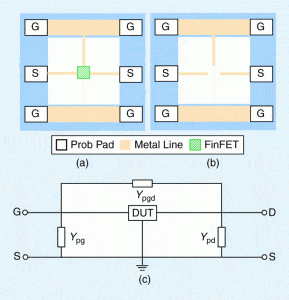 With the recent rapid improvement of wireless communication rates [1], [2], the cutoff frequency of semiconductor devices has gradually increased [3], [4], and products with large signal bandwidth circuits have become a hot topic [5], [6], [7]. Port-to-port signal transmission and coupling mechanisms are also becoming more complex with the increases in frequency, presenting a challenge for high-frequency on-chip measurement [8], [9]. An accurate calibration must be applied to eliminate deviations between the probe terminal and the internal port of the device [10].
With the recent rapid improvement of wireless communication rates [1], [2], the cutoff frequency of semiconductor devices has gradually increased [3], [4], and products with large signal bandwidth circuits have become a hot topic [5], [6], [7]. Port-to-port signal transmission and coupling mechanisms are also becoming more complex with the increases in frequency, presenting a challenge for high-frequency on-chip measurement [8], [9]. An accurate calibration must be applied to eliminate deviations between the probe terminal and the internal port of the device [10].
In this review, the “Different De-Embedding Methods” section presents a brief overview of the different de-embedding techniques and their respective advantages and shortcomings. The “Results and Discussion” section provides a comparative analysis of the de-embedding results from the different de-embedding techniques on the measurement data. Finally, the last section presents the authors’ conclusions.
Read the full article in Microwave Magazine here:
https://ieeexplore.ieee.org/stamp/stamp.jsp?tp=&arnumber=10420833
– WiM Media Working Group 2025
Hardware Design Challenges and Modulation Schemes in Joint Communication and Sensing
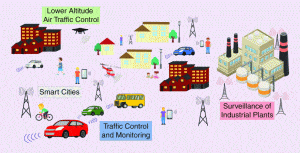 This article will summarize hardware requirements, potential applications, possible waveforms, and common techniques for JCAS to classify three different groups of JCAS systems: multicarrier systems, single-carrier systems, and radar-centric (RC) JCAS systems. The potential of these subcategories will be discussed, and their limits will be shown in the “Overview of Different JCAS Systems” section. The “Design Decisions in Hardware Components” section focuses on hardware design challenges that arise in antenna systems and active hardware components. Finally, published hardware systems and simulations are presented briefly in the “Comparison of Published Simulations and JCAS Systems” section. Their performance is discussed, along with the state of the art of JCAS systems.
This article will summarize hardware requirements, potential applications, possible waveforms, and common techniques for JCAS to classify three different groups of JCAS systems: multicarrier systems, single-carrier systems, and radar-centric (RC) JCAS systems. The potential of these subcategories will be discussed, and their limits will be shown in the “Overview of Different JCAS Systems” section. The “Design Decisions in Hardware Components” section focuses on hardware design challenges that arise in antenna systems and active hardware components. Finally, published hardware systems and simulations are presented briefly in the “Comparison of Published Simulations and JCAS Systems” section. Their performance is discussed, along with the state of the art of JCAS systems.
Read the full article in Microwave Magazine here:
https://ieeexplore.ieee.org/stamp/stamp.jsp?tp=&arnumber=10420840
– WiM Media Working Group 2025
Microwave Subsurface Imaging, Sensing, and Nondestructive Testing Using Metamaterial-Inspired Planar Sensors
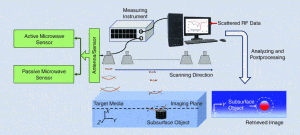 In this article, our major objective is to discuss the use of microwave and RF technology with a focus on metamaterial-inspired planar sensors, including plasmonic sensors for the subsurface imaging, sensing, and testing of media and structures. The article is organized as follows. First, the general concept of RF and microwave subsurface imaging is introduced. It is then followed by a detailed discussion of the classification of microwave subsurface imaging systems, with a focus on the two main types: far-field and near-field subsurface imaging systems. A comprehensive overview of subsurface imaging methods and their corresponding image reconstruction techniques is also described. Afterward, for far-field subsurface imaging as well as for near-field subsurface imaging, including planar sensor-based subsurface imaging techniques, the major design challenges and the commonly used methodologies are described. Overall, this article provides a comprehensive review of the utilization of antenna, waveguide, and metasurface (MS) lens-based systems in conventional imaging techniques as well as recent progress in the planar sensor-based subsurface imaging techniques. Finally, the article also discusses recent work carried out by the authors’ research group in this domain.
In this article, our major objective is to discuss the use of microwave and RF technology with a focus on metamaterial-inspired planar sensors, including plasmonic sensors for the subsurface imaging, sensing, and testing of media and structures. The article is organized as follows. First, the general concept of RF and microwave subsurface imaging is introduced. It is then followed by a detailed discussion of the classification of microwave subsurface imaging systems, with a focus on the two main types: far-field and near-field subsurface imaging systems. A comprehensive overview of subsurface imaging methods and their corresponding image reconstruction techniques is also described. Afterward, for far-field subsurface imaging as well as for near-field subsurface imaging, including planar sensor-based subsurface imaging techniques, the major design challenges and the commonly used methodologies are described. Overall, this article provides a comprehensive review of the utilization of antenna, waveguide, and metasurface (MS) lens-based systems in conventional imaging techniques as well as recent progress in the planar sensor-based subsurface imaging techniques. Finally, the article also discusses recent work carried out by the authors’ research group in this domain.
Read the full article in Microwave Magazine here:
https://ieeexplore.ieee.org/stamp/stamp.jsp?tp=&arnumber=10421760
– WiM Media Working Group 2025
Mirroring Physical Reality: Nonconventional Microwave Filter Synthesis
 Inline layout is one of the mechanical constraints frequently encountered when building compact and simple networks. Nevertheless, to enhance attenuation at specified frequencies, cross coupling between nonadjacent resonant cavities is often needed to produce transmission zeros (TZs), which will violate the inline configuration and complicate the design and tuning process. The cross coupling can be positive or negative in synthesis results, usually corresponding to inductive and capacitive coupling structures, respectively. For waveguide technology, higher order modes are often required to implement negative coupling, which will increase the filter size. For coaxial technology, suspended capacitive probes are commonly adopted to realize negative coupling, which may introduce more loss, increase fabrication and tuning expenses, and degrade power capacity. Therefore, negative cross coupling is usually avoided, which means that an all-positive-coupling configuration is another physical restriction in real designs. This article will present research that tackles the problems we have mentioned and provide a new perspective on modern filter synthesis theories: one driven by physical reality and further guided by physical realization.
Inline layout is one of the mechanical constraints frequently encountered when building compact and simple networks. Nevertheless, to enhance attenuation at specified frequencies, cross coupling between nonadjacent resonant cavities is often needed to produce transmission zeros (TZs), which will violate the inline configuration and complicate the design and tuning process. The cross coupling can be positive or negative in synthesis results, usually corresponding to inductive and capacitive coupling structures, respectively. For waveguide technology, higher order modes are often required to implement negative coupling, which will increase the filter size. For coaxial technology, suspended capacitive probes are commonly adopted to realize negative coupling, which may introduce more loss, increase fabrication and tuning expenses, and degrade power capacity. Therefore, negative cross coupling is usually avoided, which means that an all-positive-coupling configuration is another physical restriction in real designs. This article will present research that tackles the problems we have mentioned and provide a new perspective on modern filter synthesis theories: one driven by physical reality and further guided by physical realization.
Read the full article in Microwave Magazine here:
https://ieeexplore.ieee.org/stamp/stamp.jsp?tp=&arnumber=10421758
– WiM Media Working Group 2025
April 2023 Focus Issue on Research by WiM
Guest Editor: Jasmin Grosinger
 This is the second year of a dedicated Microwave Magazine focus issue devoted to WiM, organized by Guedt Editor Jasmin Grosinger.
This is the second year of a dedicated Microwave Magazine focus issue devoted to WiM, organized by Guedt Editor Jasmin Grosinger.
This month’s theme has a very similar theme to several issues in the first quarter of 2022: research by women in microwaves. This month, we focus on more contributions to microwave technology by several women researchers from the United States, Europe, and China.
The first article by Grosinger looks at ultralow-power microwave circuits and systems that help meet some of the needs and challenges of Internet of Things applications. The second technical feature by Yuan presents an approach using S-parameters to calculate the wireless power transfer efficiency for both single-input, single-output as well as multiple-input, multiple-output systems and provides some examples to show the benefits of the method. The next technical feature by Mertens et al. describes using typical microwave laboratory vector network analyzers (VNAs) to observe unique reflected frequency signatures from biological materials as a way to determine their various biological characteristics. The last technical feature, authored by Qin et al. covers design techniques that can be employed to increase the tuning range of these widely used oscillator circuit topologies.
Read the “From the Editor’s Desk” column by Editor -in-Chief on this focus issue in Microwave Magazine here:
https://ieeexplore.ieee.org/stamp/stamp.jsp?tp=&arnumber=10058759
– WiM Media Working Group 2025
Robustly Operating: Passive Near-Field Communication Systems in Metal Environments
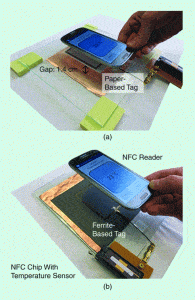 The Internet of Things (IoT) refers to a structure that links everyday objects and the Internet. To enable the IoT, a massive deployment of wireless IoT nodes is required; predictions indicate that trillions of these nodes will be needed. This trend raises sustainability issues on environmental, economic, and societal levels. Concerning environmental and economic problems, a significant design challenge is to create wireless IoT nodes that operate at ultralow power to avoid the ecotoxicity of batteries and the prohibitive maintenance costs of battery replacement [1]. Another design challenge is to reach high levels of integration based on low-cost CMOS technologies [2] to limit the carbon footprint and costs associated with the nodes’ production and end of life. Concerning societal issues, a significant design challenge is to guarantee the security and privacy of data in IoT nodes.
The Internet of Things (IoT) refers to a structure that links everyday objects and the Internet. To enable the IoT, a massive deployment of wireless IoT nodes is required; predictions indicate that trillions of these nodes will be needed. This trend raises sustainability issues on environmental, economic, and societal levels. Concerning environmental and economic problems, a significant design challenge is to create wireless IoT nodes that operate at ultralow power to avoid the ecotoxicity of batteries and the prohibitive maintenance costs of battery replacement [1]. Another design challenge is to reach high levels of integration based on low-cost CMOS technologies [2] to limit the carbon footprint and costs associated with the nodes’ production and end of life. Concerning societal issues, a significant design challenge is to guarantee the security and privacy of data in IoT nodes.
Read the full article in Microwave Magazine here:
https://ieeexplore.ieee.org/stamp/stamp.jsp?tp=&arnumber=10058794
– WiM Media Working Group 2025
S-Parameters for Calculating the Maximum Efficiency of a MIMO-WPT System
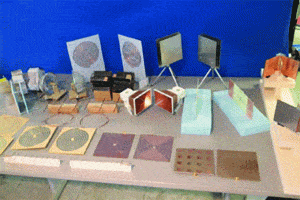 In this article, the MPTEs of SISO-WPT and multiple-transmitter, single-receiver MISO-WPT systems are highlighted. The approach to calculating the PTE and MPTE of MIMO-WPT systems is based on the Rayleigh quotient (M-RQ), while the approach [6] to achieve the MPTE of SISO-WPT uses matching circuit conditions (M-MC). Numerical MPTE examples of typical SISO-WPT systems are presented in the “MPTEs of SISO-WPT Examples” section. MPTEs obtained using M-RQ are compared with those obtained by M-MC to demonstrate the effectiveness of M-RQ and reveal the physical meaning of the condition for achieving the MPTE by using M-RQ in the SISO-WPT case. In the MISO case, MISO-WPT systems’ MPTEs versus the distance between multiple transmitters and the receiver are compared to show how the receiver’s location affects the MPTE, in the “MPTEs of MISO-WPT Systems” section. The MPTEs versus the number of transmitters is presented to see how the number of transmitters affects the MPTE.
In this article, the MPTEs of SISO-WPT and multiple-transmitter, single-receiver MISO-WPT systems are highlighted. The approach to calculating the PTE and MPTE of MIMO-WPT systems is based on the Rayleigh quotient (M-RQ), while the approach [6] to achieve the MPTE of SISO-WPT uses matching circuit conditions (M-MC). Numerical MPTE examples of typical SISO-WPT systems are presented in the “MPTEs of SISO-WPT Examples” section. MPTEs obtained using M-RQ are compared with those obtained by M-MC to demonstrate the effectiveness of M-RQ and reveal the physical meaning of the condition for achieving the MPTE by using M-RQ in the SISO-WPT case. In the MISO case, MISO-WPT systems’ MPTEs versus the distance between multiple transmitters and the receiver are compared to show how the receiver’s location affects the MPTE, in the “MPTEs of MISO-WPT Systems” section. The MPTEs versus the number of transmitters is presented to see how the number of transmitters affects the MPTE.
Read the full article by Marie Mertens in Microwave Magazine here:
https://ieeexplore.ieee.org/stamp/stamp.jsp?tp=&arnumber=10058755
– WiM Media Working Group 2025
Dielectric Spectroscopy: Revealing the True Colors of Biological Matter
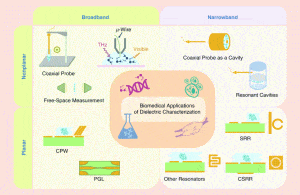 Accurate characterization of biological matter, for example, in tissue, cells, and biological fluids, is of high importance. Moreover, it is imperative to investigate the effectiveness and toxicity of pharmaceutical treatments before administration in clinical practice. However, biological matter characterization still faces many challenges. State-of-the-art imaging and characterization methods have drawbacks, such as the requirement to attach difficult-to-find and costly labels to the biological target (e.g., COVID-19 rapid tests), expensive equipment (e.g., magnetic resonance imaging), low accuracy (e.g., ultrasound), use of ionizing radiation (e.g., X-rays), and invasiveness. The characterization of biological matter using microwave (µW), millimeter-wave (mmW), and terahertz (THz) spectroscopy is a promising alternative: it is label-free, does not require ionizing radiation, and can be noninvasive. Moreover, there is a significant difference in how different biological materials absorb, reflect, and transmit electromagnetic (EM) waves [4] that is due to the difference in their dielectric properties. A material’s complex permittivity can be calculated from the reflection and transmission of EM waves through the material, described by the S-parameters. Spectroscopy using μW, mmW, and THz EM waves has shown potential to sense the concentration of important biomarkers, such as glucose in diabetes patients, DNA and proteins that inform about genetic disorders, and cancer biomarkers to distinguish healthy matter from cancerous matter. These applications will be further elaborated on in the section “Dielectric Spectroscopy Techniques.
Accurate characterization of biological matter, for example, in tissue, cells, and biological fluids, is of high importance. Moreover, it is imperative to investigate the effectiveness and toxicity of pharmaceutical treatments before administration in clinical practice. However, biological matter characterization still faces many challenges. State-of-the-art imaging and characterization methods have drawbacks, such as the requirement to attach difficult-to-find and costly labels to the biological target (e.g., COVID-19 rapid tests), expensive equipment (e.g., magnetic resonance imaging), low accuracy (e.g., ultrasound), use of ionizing radiation (e.g., X-rays), and invasiveness. The characterization of biological matter using microwave (µW), millimeter-wave (mmW), and terahertz (THz) spectroscopy is a promising alternative: it is label-free, does not require ionizing radiation, and can be noninvasive. Moreover, there is a significant difference in how different biological materials absorb, reflect, and transmit electromagnetic (EM) waves [4] that is due to the difference in their dielectric properties. A material’s complex permittivity can be calculated from the reflection and transmission of EM waves through the material, described by the S-parameters. Spectroscopy using μW, mmW, and THz EM waves has shown potential to sense the concentration of important biomarkers, such as glucose in diabetes patients, DNA and proteins that inform about genetic disorders, and cancer biomarkers to distinguish healthy matter from cancerous matter. These applications will be further elaborated on in the section “Dielectric Spectroscopy Techniques.
Read the full article by Marie Mertens in Microwave Magazine here:
https://ieeexplore.ieee.org/stamp/stamp.jsp?tp=&arnumber=10058808
– WiM Media Working Group 2025
Microwave LC Oscillators: Multimode Switching Techniques
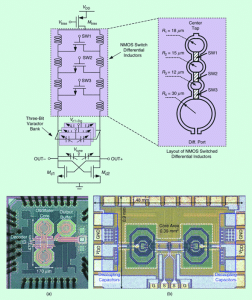 The rapid development of wireless communications, software-defined radios, and ultrawideband (UWB) engenders an ever-increasing demand for clock generators that fully covers multiple frequency bands. As the “heartbeat” that pumps clock generators, such as phase-locked loops (PLLs), microwave oscillators with wideband frequency tuning range (TR) are thus attracting a great deal of research interest.
The rapid development of wireless communications, software-defined radios, and ultrawideband (UWB) engenders an ever-increasing demand for clock generators that fully covers multiple frequency bands. As the “heartbeat” that pumps clock generators, such as phase-locked loops (PLLs), microwave oscillators with wideband frequency tuning range (TR) are thus attracting a great deal of research interest.
Multimode switching techniques can greatly expand the frequency coverage for microwave LC oscillators by introducing more resonant modes; thus, they are good options for the realization of wideband oscillators. Therefore, this article aims to present multimode switching design techniques for microwave LC oscillators to extend their frequency TR and provide researchers interested in this domain with a comprehensive understanding of various aspects of these techniques.
Read the full article in Microwave Magazine here:
https://ieeexplore.ieee.org/stamp/stamp.jsp?tp=&arnumber=10058805
– WiM Media Working Group 2025
March 2022 Focus Issue on Research by WiM
Guest Editors: Jasmin Grosinger, Wenquan Che, Sherry Hess
 This March 2022 issue completes our 2022 focus on Research by Women in Microwaves (WiM), with new technical features highlighting the work performed by some women microwave researchers throughout the world. As outlined lined by the Guest Editors in the previous issue, the WiM focus issue this year spans both the February and March 2022 issues of the magazine. In this second part of the WiM issue, the final three technical features cover a wide range of research topics.
This March 2022 issue completes our 2022 focus on Research by Women in Microwaves (WiM), with new technical features highlighting the work performed by some women microwave researchers throughout the world. As outlined lined by the Guest Editors in the previous issue, the WiM focus issue this year spans both the February and March 2022 issues of the magazine. In this second part of the WiM issue, the final three technical features cover a wide range of research topics.
In their article titled “Wearable, Energy-Autonomous RF Microwave Systems,” A. Costanzo et al. discuss microwave and millimeter-wave wireless systems for the Internet of Things (IoT) that provide energy autonomy and batteryless operation, with an emphasis on devices fabricated using textiles or flexible materials. P. Dhull et al., in their article titled “Internet of Things Networks,” focus on enabling simultaneous wireless information and power transfer in IoT networks and their base stations, elaborating on beamforming and signal design to improve the wireless performance. In “Space Tags,” J. Grosinger and A. Michalowska-Forsyth review passive wireless sensor tags and their use in space, focusing on their ultralow-power operation and radiation hardness. This article focuses exclusively on passive wireless sensors exploiting backscatter RF technology. In addition to these technical features, please read the “Women in Microwaves” column, where V. Palazzi discusses her thoughts on the Three Minute Thesis (3MT) competition and how presenting to a 3MT audience differs from delivering the usual technical talk.
Read the “From the Editor’s Desk” column by Editor-in-Chief in Microwave Magazine here:
https://ieeexplore.ieee.org/stamp/stamp.jsp?tp=&arnumber=9702109
– WiM Media Working Group 2025
Wearable, Energy-Autonomous RF Microwave Systems
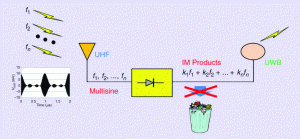 In the near future, we will be surrounded in our daily lives by a multitude of small and relatively inexpensive computing devices that are equipped with wireless communication and sensing featuring the concept of “pervasive intelligence,” a basis from which we can envision our future world as an Internet of Things/Internet of Everything (IoT/IoE) in terms of both a consumer IoT/IoE and the Industrial IoT. One of the key desired characteristics of an IoT wireless sensor node is its ability to operate autonomously by means of energy harvesting (EH) rather than relying on bulky batteries, which have a limited lifetime. Furthermore, for many of the aforementioned scenarios, wearable solutions are foreseen to further increase the pervasive diffusion of the IoT paradigm, enabling a multitude of devices and individuals to be connected to each other.
In the near future, we will be surrounded in our daily lives by a multitude of small and relatively inexpensive computing devices that are equipped with wireless communication and sensing featuring the concept of “pervasive intelligence,” a basis from which we can envision our future world as an Internet of Things/Internet of Everything (IoT/IoE) in terms of both a consumer IoT/IoE and the Industrial IoT. One of the key desired characteristics of an IoT wireless sensor node is its ability to operate autonomously by means of energy harvesting (EH) rather than relying on bulky batteries, which have a limited lifetime. Furthermore, for many of the aforementioned scenarios, wearable solutions are foreseen to further increase the pervasive diffusion of the IoT paradigm, enabling a multitude of devices and individuals to be connected to each other.
This article presents an overview of some recently proposed energy-autonomous wearable devices that exploits both of the approaches described previously, with an emphasis on devices fabricated using textile or flexible materials.
Read the full article in Microwave Magazine here:
https://ieeexplore.ieee.org/stamp/stamp.jsp?tp=&arnumber=9702105
– WiM Media Working Group 2025
Internet of Things Networks: Enabling Simultaneous Wireless Information and Power Transfer
 The number of sensors deployed in the world is expected to explode in the near future. At this moment, nearly 30 billion Internet of Things (IoT) devices are connected, and the number is expected to double in the next four years. While not all of these are battery powered, as technology becomes smaller and mobility becomes more important to consumers, soon a larger portion will be. This forecast predicts that the number of machine-to-machine devices will have the largest increase, representing nearly 50% of all devices in 2023. These devices are typically small and therefore ideal candidates to be wirelessly powered. Typical examples are health-care monitoring, smart homes, and industrial applications.
The number of sensors deployed in the world is expected to explode in the near future. At this moment, nearly 30 billion Internet of Things (IoT) devices are connected, and the number is expected to double in the next four years. While not all of these are battery powered, as technology becomes smaller and mobility becomes more important to consumers, soon a larger portion will be. This forecast predicts that the number of machine-to-machine devices will have the largest increase, representing nearly 50% of all devices in 2023. These devices are typically small and therefore ideal candidates to be wirelessly powered. Typical examples are health-care monitoring, smart homes, and industrial applications.
This article focuses on enabling simultaneous wireless information and power transfer in IoT networks and their base stations, elaborating on beamforming and signal design to improve the wireless performance.
Read the full article in Microwave Magazine here:
https://ieeexplore.ieee.org/stamp/stamp.jsp?tp=&arnumber=9702122
– WiM Media Working Group 2025
Space Tags: Ultra-Low-Power Operation and Radiation Hardness for Passive Wireless Sensor Tags
 Space agencies worldwide have a long-term vision of sending human missions to Mars [1]. The next favorable launch window occurs in 2033, and plans are ongoing to realize such endeavors. An essential part of this preparation is the search for new technologies to mitigate mission performance risks. A critical further technological advancement is passive or batteryless wireless sensor technology [2], [3], as used in the Internet of Things (IoT) [4], which can be favorably used to continuously monitor the physiological conditions of crew members in the space habitat and structural health of spaceflight equipment.
Space agencies worldwide have a long-term vision of sending human missions to Mars [1]. The next favorable launch window occurs in 2033, and plans are ongoing to realize such endeavors. An essential part of this preparation is the search for new technologies to mitigate mission performance risks. A critical further technological advancement is passive or batteryless wireless sensor technology [2], [3], as used in the Internet of Things (IoT) [4], which can be favorably used to continuously monitor the physiological conditions of crew members in the space habitat and structural health of spaceflight equipment.
this article reviews the existing work on batteryless wireless sensors for their reliable ultra-low-power operation and evaluates perspectives for their radiation hardness. It focuses exclusively on passive wireless sensors exploiting a backscatter RF technology, in particular, the ultra-high frequency (UHF) RF identification (RFID) technology based on the ISO/IEC 18000-6 standard operating in a frequency range of 860–960 MHz, in contrast to previous work on backscatter tags in space operating at higher frequencies [5] and battery-assisted wireless IoT sensor systems in radiation environments [6].
Read the full article in Microwave Magazine here:
https://ieeexplore.ieee.org/stamp/stamp.jsp?tp=&arnumber=9702102
– WiM Media Working Group 2025
February 2022 Focus Issue on Research by WiM
Guest Editors: Jasmin Grosinger, Wenquan Che, Sherry Hess
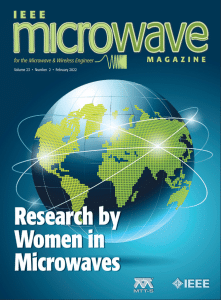 This inaugural issue on Women in Microwaves (WiM) of IEEE Microwave Magazine highlights female researchers and spotlights their research. In this issue, we hope to focus attention particularly from young professionals, on the microwave theory and techniques-related publications of a few female researchers. Two issues of IEEE Microwave Magazine, with a total of six feature articles, will be devoted to the excellent technical contributions of women in microwave theory and techniques.
This inaugural issue on Women in Microwaves (WiM) of IEEE Microwave Magazine highlights female researchers and spotlights their research. In this issue, we hope to focus attention particularly from young professionals, on the microwave theory and techniques-related publications of a few female researchers. Two issues of IEEE Microwave Magazine, with a total of six feature articles, will be devoted to the excellent technical contributions of women in microwave theory and techniques.
In this issue, Han et al. review frequency-selective radome absorbers that combine frequency-selective surfaces with absorbers, thus—when applied—reducing the radar cross sections of antenna radomes considerably, in their article “Frequency-Selective Rasorbers: A View of Frequency-Selective Rasorbers and their Application in Reducing the Radar Cross Sections of Antennas.” Next, Marzall et al.’s article “Active and Passive Components for Broadband Transmit Phased Arrays: Broadband Transmit Front-End Components” focuses on active and passive transmitter front-end components of phased array antennas, providing broadband behavior in the microwave and millimeter-wave ranges. Hubrechsen et al. provide an overview of how to perform reverberation-chamber wireless testing for Internet of Things (IoT) devices, focusing on the transmission protocol narrowband IoT in “Reverberation Chamber Metrology for Wireless Internet of Things Devices: Flexibility in Form Factor, Rigor in Test.”
Read the “From the Guest Editors’ Desk” column on this focus issue in Microwave Magazine here:
https://ieeexplore.ieee.org/stamp/stamp.jsp?tp=&arnumber=9676523
– WiM Media Working Group 2025
Frequency-Selective Rasorbers
A View of Frequency-Selective Rasorbers and Their Application in Reducing the Radar Cross Sections of Antennas
 A frequency-selective surface (FSS) can be employed as a spatial filter for incident electromagnetic (EM) waves, which are most often used in radome design to protect the antennas and to reduce the radar cross section (RCS) of the antenna system [1]–[3]. In-band signals transmit through the FSS with little power loss, while out-of-band incoming waves are reflected strongly, making them detectable by radar. Thus, to further reduce the biostatic/multistate RCS of the radome, circuit analog absorbers or absorbing materials are introduced into the radome design. As a result, the out-of-band signals are absorbed and reflection is reduced.
A frequency-selective surface (FSS) can be employed as a spatial filter for incident electromagnetic (EM) waves, which are most often used in radome design to protect the antennas and to reduce the radar cross section (RCS) of the antenna system [1]–[3]. In-band signals transmit through the FSS with little power loss, while out-of-band incoming waves are reflected strongly, making them detectable by radar. Thus, to further reduce the biostatic/multistate RCS of the radome, circuit analog absorbers or absorbing materials are introduced into the radome design. As a result, the out-of-band signals are absorbed and reflection is reduced.
A new structure has been developed that combines an FSS with an absorber, termed a radome absorber (rasorber) or a frequency-selective rasorber (FSR). Due to their outstanding performance in guaranteeing both good communication and the stealth of an antenna system, FSRs are attracting a great deal of attention. There are two main types of FSRs, as shown in Figure 1. An FSR with a passband in the absorption band can be applied as the radome of the antenna, while an FSR with a stopband is conventionally applied as the reflection plane/ground plane of the antenna.
Read the full article in Microwave Magazine here:
https://ieeexplore.ieee.org/stamp/stamp.jsp?tp=&arnumber=9676505
– WiM Media Working Group 2025
Active and Passive Components for Broadband Transmit Phased Arrays: Broadband Transmit Front-End Components
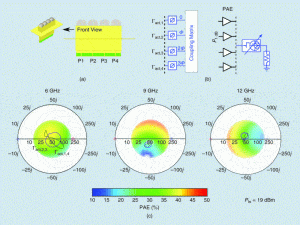 This article addresses microwave and millimeter-wave active and passive components for broadband-phased array front ends, focusing mostly on the transmit path. Figure 1 shows a high-level block diagram that outlines the article content. The main blocks include the beamforming network, amplification stage, isolation stage between transmit and receive, and the final radiating aperture. The digital control and dc supply are not discussed here but are an integral part of the system. The last component in the chain is the passive antenna itself, and its radiating and matching characteristics affect the entire system performance. The growing variety of applications and system requirements lead to the need of scalable, modularized devices for transmit and receive chains.
This article addresses microwave and millimeter-wave active and passive components for broadband-phased array front ends, focusing mostly on the transmit path. Figure 1 shows a high-level block diagram that outlines the article content. The main blocks include the beamforming network, amplification stage, isolation stage between transmit and receive, and the final radiating aperture. The digital control and dc supply are not discussed here but are an integral part of the system. The last component in the chain is the passive antenna itself, and its radiating and matching characteristics affect the entire system performance. The growing variety of applications and system requirements lead to the need of scalable, modularized devices for transmit and receive chains.
This article presents previous and ongoing studies of the transmit-chain front-end components, including design approaches and performance tradeoff analyses. The “Beamforming Networks” section overviews three broadband analog beamforming approaches: octave-bandwidth monolithic microwave integrated circuit (MMIC) phase shifters based on loaded transmission lines; an octave-bandwidth Butler matrix; and a millimeter-wave frequency-steered array. Throughout the article, we focus on III–V semiconductor (GaAs and GaN) MMICs for the active components with potential for heterogeneous integration.
Read the full article in Microwave Magazine here:
https://ieeexplore.ieee.org/stamp/stamp.jsp?tp=&arnumber=9676525
– WiM Media Working Group 2025
Reverberation Chamber Metrology for Wireless Internet of Things Devices: Flexibility in Form Factor, Rigor in Test
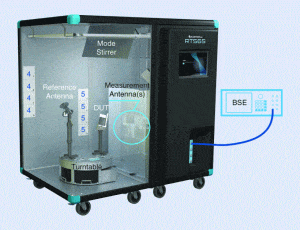 In this work, we provide an overview of how to perform reverberation-chamber wireless testing for IoT devices. We first provide a brief overview to introduce the main concepts in the use of reverberation chambers for OTA testing of wireless devices. We discuss reverberation-chamber-specific components of uncertainty in these types of measurements, such as the number of measured samples collected and the chamber configuration, including the efficiency measurement of the antennas. Our examples will focus on the characterization of low-cost cellular-enabled devices that use a spectrally efficient transmission protocol called narrowband IoT (NB-IoT) [16]. Because the antenna efficiency can be a complicated measurement for narrowband devices and it is an important contribution to other device performance metrics, we also discuss this. We then provide an example of an NB-IoT device measurement with corresponding uncertainties. These examples illustrate the flexibility that reverberation chambers can provide in terms of device placement within the chamber and the accuracy that can be achieved with relatively straightforward calibration procedures.
In this work, we provide an overview of how to perform reverberation-chamber wireless testing for IoT devices. We first provide a brief overview to introduce the main concepts in the use of reverberation chambers for OTA testing of wireless devices. We discuss reverberation-chamber-specific components of uncertainty in these types of measurements, such as the number of measured samples collected and the chamber configuration, including the efficiency measurement of the antennas. Our examples will focus on the characterization of low-cost cellular-enabled devices that use a spectrally efficient transmission protocol called narrowband IoT (NB-IoT) [16]. Because the antenna efficiency can be a complicated measurement for narrowband devices and it is an important contribution to other device performance metrics, we also discuss this. We then provide an example of an NB-IoT device measurement with corresponding uncertainties. These examples illustrate the flexibility that reverberation chambers can provide in terms of device placement within the chamber and the accuracy that can be achieved with relatively straightforward calibration procedures.
Read the full article in Microwave Magazine here:
https://ieeexplore.ieee.org/stamp/stamp.jsp?tp=&arnumber=9676518
– WiM Media Working Group 2025

